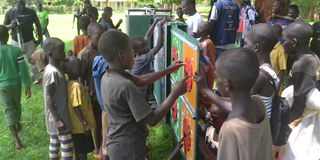Mbale has highest number of street children - survey

Children taking part in several plays during the International Day for Street Children national celebrations held in Jinja City on April 14, 2023. PHOTO | DENIS EDEMA
What you need to know:
- While some street children, especially from Karamoja Sub-region, were pushed to city streets by poverty, others, especially those born in Kampala, found themselves on the streets because of domestic violence or loss of parents.
Mbale has the highest number of street children compared to other Cities, with Jinja contributing 2.5 percent of their total number countrywide, according to latest findings.
This was revealed at the weekend during the International Day for Street Children held in Jinja, which is one of the Cities challenged by street children.
The celebrations drew several organisations working with street children across the country, including Children at Risk Action Network, Frontline Social Work Organisation, Uganda Change Agent Association, Jinja Connect, and Rescue Foundation for Children among others.
Mr Robert Sanyu, from Kampala-based Rescue Foundation for Children, said research conducted in 2022 indicates that Mbale has the highest number of street children because it is one of the corridors through which they access other cities like Jinja and Kampala, yet it (Mbale) has few organisations to address such issues.
“There are about 16,000 children on the streets across the country, with Jinja contributing about 400 (2.5 percent),” Mr Sanyu said at the weekend.
Mr Fred Mabonga from the National Children Authority, who represented the Executive Director Mr Martin Kiiza, said last year, the government through the Ministry of Gender, Labour and Social Development, came up with a plan to review the National Street Children Strategy (2008).
Mr Mabonga said the review, which involved meetings with stakeholders, aimed at securing a consultant to come up with a report on how many children are living in the City and Town streets in the country, and where they are coming from among other findings.
While some street children, especially from Karamoja Sub-region, were pushed to city streets by poverty, others, especially those born in Kampala, found themselves on the streets because of domestic violence or loss of parents.
The government, through the Ministry of GLSD has stepped up efforts to evict all children from city streets and take them to rehabilitation centres; however, the majority of them are not willing to leave and thus end up in city slums.
Violence on streets
Several children who testified on behalf of their colleagues complained of the alleged high-handedness by police and other law enforcement agencies, which they accused of brutality, while another child said some adult colleagues subject them to acts of homosexuality.
Findings from an enumeration of street children carried out in 2019 by Retrak Uganda in collaboration with the Gender ministry and Uganda Bureau of Statistics (Ubos) showed that there were more than 2,600 children living on streets between the age of 7 and 17 years, while 1,410 children aged between 7 and 17 years were estimated to be working on streets.
The in-charge of the Child Family Protection Unit at Jinja Police Station, Ms Cissy Logose, said many factors push children away from their biological parents and relatives to the street, including death of parents and are left with relatives or stepmothers who mistreat them.
Others, she said, include a number of rehabilitation centres and social workers in the cities to attend to their problems and conditions, including sickness.
Every year on April 12, International Day for Street Children provides a voice for children that live on the street so their rights cannot be ignored. The day provides opportunities for human rights organisations to spread awareness for the number of street children throughout the world.
According to recent statistics, up to 150 million children throughout the world live on the street, with some living on the street with their families, others spend majority of their time on the street begging for food and money, while others live on the street as orphans with no family or no home to return to at night.
In 1989, the United Nations held the Convention on the Rights of the Child, which highlighted some of the rights that all children in the world should have, including the right to a stable, loving, and nurturing environment, healthcare and nutrition, clean water and electric power, equal opportunities and to live in dignity and freedom.



